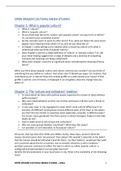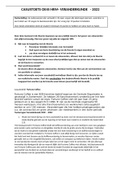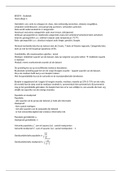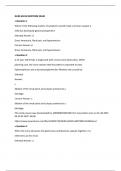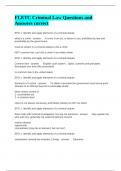OPEN VRAGEN CULTURAL MEDIA STUDIES
Chapter 1: What is popular culture?
• What is ‘culture’?
• What is ‘popular culture’?
• Do you think that the terms ‘culture’ and ‘popular culture’ are easy to fix or define?
Or, are both terms somewhat elusive?
• Do the concepts seem to point to other terms? If so, what are these? Do some terms
appear more important than others? If so, why do you think this is?
• Is Chapter 1 really setting out to stabilize what is meant by culture or fix what is
understood when we think of popular culture?
• Does Chapter 1 point to a single definition of ‘culture’ or ‘popular culture’? Or, did
your initial reading suggest that a range of debates and a diversity of competing
concepts and meanings are being underlined?
• What does Chapter 1 point to as significant when considering the meaning of these
terms?
When you think about popular culture and culture, what do you consider? Can you think of
something that you define as ‘culture’ that others don’t? Would you argue, for instance, that
contemporary art is culture? Does this include graffiti on a wall outside your house? If that
graffiti is sold for a lot of money, or displayed in an art gallery, does this change how you
define it?
Chapter 2: The ‘culture and civilization’ tradition
• To what extent do those with political power supervise the culture of those without
political power?
• Why was industrialization and the rise of cities and towns in Britain such a threat to
civilization?
• Is your own town or city segregated in ways which mark cultural differences? For
instance, do different social groups occupy different parts of the town or city where
you live? Are city centres or suburban areas organized, culturally, in different ways?
Are leisure zones gendered? Are there spaces in which teenagers hang out and older
adults do not?
• Does it make sense to link culture and civilization?
• Why are some groups labelled ‘uncivilized’? What does this mean?
• Is it possible, or even desirable, to fix popular culture?
Of course, that was then (the 1930s and 1940s). Surely, these days, we don’t think the
masses should receive their ‘amusement’ from above? We wouldn’t subscribe to the belief
that the masses should be told what’s best for them – by their ‘betters’, would we? But wait!
Let’s just think about this for a moment. Just as Arnold’s influence is still in evidence –
perhaps Leavisism continues to inflect the ways in which so-called ‘popular culture’ is
configured and represented in our everyday lives too?
Identify the key bookstores in your local town or city. What is the availability of the following
texts?
OPEN VRAGEN CULTURAL MEDIA STUDIES – Gilles 1
, • Plays by Shakespeare
• The complete works of Catherine Cookson
• Mills & Boon (or any popular romantic novels)
• The lyrics of songs by Dusty Springfield
• The rise and fall of the Roman Empire
• A history of the shipyard industry
• Hello magazine
• Graphic novels
• The Communist Manifesto
Do you think studying culture is as much about what you read as about why we read
something and what we do with reading? In other words, what is the function of reading?
What does it mean to you?
Although the Leavisite tradition has been questioned, Chapter 2 notes how their analytical
tools (closer reading, textual scrutiny, attention to form) was taken up and subsequently
applied to popular culture texts across a number of disciplines. One significant effect then of
the Leaviste tradition was that popular culture was given space and, as such, became a part
of the study of culture, even though Leavis himself might well have been horrified by this.
Chapter 2 of Cultural Theory and Popular Culture gives an example of how a Leavisite
approach was adopted (both implicitly and explicitly) in school curricula in the past. Perhaps
it is worth recalling your English lessons/lectures and examinations at school or college.
Think about:
• What literary texts were you encouraged to value?
• What literary texts were the set texts and why were they set? What texts weren’t
set?
• Did you feel you ought to take pleasure from some kinds of texts and not others? Can
the pleasure a text gives you be circumscribed by someone else?
• What sorts of questions were asked about the literary texts? For example, was plot
more important than form, or content, or style, genre and audience/readership? Did
you gain pleasure by analysing it in this way? Or did it detract from your enjoyment?
• Did the author’s name make all the difference? Who decided that some names were
included as the important texts to read?
• Should the text remind you of a better, more golden past? Should the text reflect
society or question society?
If you are now, as an adult, a member of a book group, what texts are selected to be read?
On what basis? How does discussion of these ensue? Next time you meet, analyse the
discussion in relation to what you critically now know about Leavism.
Chapter 3: Culturalism
• Should culture simply be defined as ‘a way of life’?
• If so, how do we study and document a way of life and lived cultures?
• Who and what counts as evidence of a way of life? What counts as history and whose
history are we talking about? Were the 1930s really better than the 1950s?
• What is the relationship between working-class culture and popular culture? Is it
possible to identify, specifically, a working-class way of life?
OPEN VRAGEN CULTURAL MEDIA STUDIES – Gilles 2
Chapter 1: What is popular culture?
• What is ‘culture’?
• What is ‘popular culture’?
• Do you think that the terms ‘culture’ and ‘popular culture’ are easy to fix or define?
Or, are both terms somewhat elusive?
• Do the concepts seem to point to other terms? If so, what are these? Do some terms
appear more important than others? If so, why do you think this is?
• Is Chapter 1 really setting out to stabilize what is meant by culture or fix what is
understood when we think of popular culture?
• Does Chapter 1 point to a single definition of ‘culture’ or ‘popular culture’? Or, did
your initial reading suggest that a range of debates and a diversity of competing
concepts and meanings are being underlined?
• What does Chapter 1 point to as significant when considering the meaning of these
terms?
When you think about popular culture and culture, what do you consider? Can you think of
something that you define as ‘culture’ that others don’t? Would you argue, for instance, that
contemporary art is culture? Does this include graffiti on a wall outside your house? If that
graffiti is sold for a lot of money, or displayed in an art gallery, does this change how you
define it?
Chapter 2: The ‘culture and civilization’ tradition
• To what extent do those with political power supervise the culture of those without
political power?
• Why was industrialization and the rise of cities and towns in Britain such a threat to
civilization?
• Is your own town or city segregated in ways which mark cultural differences? For
instance, do different social groups occupy different parts of the town or city where
you live? Are city centres or suburban areas organized, culturally, in different ways?
Are leisure zones gendered? Are there spaces in which teenagers hang out and older
adults do not?
• Does it make sense to link culture and civilization?
• Why are some groups labelled ‘uncivilized’? What does this mean?
• Is it possible, or even desirable, to fix popular culture?
Of course, that was then (the 1930s and 1940s). Surely, these days, we don’t think the
masses should receive their ‘amusement’ from above? We wouldn’t subscribe to the belief
that the masses should be told what’s best for them – by their ‘betters’, would we? But wait!
Let’s just think about this for a moment. Just as Arnold’s influence is still in evidence –
perhaps Leavisism continues to inflect the ways in which so-called ‘popular culture’ is
configured and represented in our everyday lives too?
Identify the key bookstores in your local town or city. What is the availability of the following
texts?
OPEN VRAGEN CULTURAL MEDIA STUDIES – Gilles 1
, • Plays by Shakespeare
• The complete works of Catherine Cookson
• Mills & Boon (or any popular romantic novels)
• The lyrics of songs by Dusty Springfield
• The rise and fall of the Roman Empire
• A history of the shipyard industry
• Hello magazine
• Graphic novels
• The Communist Manifesto
Do you think studying culture is as much about what you read as about why we read
something and what we do with reading? In other words, what is the function of reading?
What does it mean to you?
Although the Leavisite tradition has been questioned, Chapter 2 notes how their analytical
tools (closer reading, textual scrutiny, attention to form) was taken up and subsequently
applied to popular culture texts across a number of disciplines. One significant effect then of
the Leaviste tradition was that popular culture was given space and, as such, became a part
of the study of culture, even though Leavis himself might well have been horrified by this.
Chapter 2 of Cultural Theory and Popular Culture gives an example of how a Leavisite
approach was adopted (both implicitly and explicitly) in school curricula in the past. Perhaps
it is worth recalling your English lessons/lectures and examinations at school or college.
Think about:
• What literary texts were you encouraged to value?
• What literary texts were the set texts and why were they set? What texts weren’t
set?
• Did you feel you ought to take pleasure from some kinds of texts and not others? Can
the pleasure a text gives you be circumscribed by someone else?
• What sorts of questions were asked about the literary texts? For example, was plot
more important than form, or content, or style, genre and audience/readership? Did
you gain pleasure by analysing it in this way? Or did it detract from your enjoyment?
• Did the author’s name make all the difference? Who decided that some names were
included as the important texts to read?
• Should the text remind you of a better, more golden past? Should the text reflect
society or question society?
If you are now, as an adult, a member of a book group, what texts are selected to be read?
On what basis? How does discussion of these ensue? Next time you meet, analyse the
discussion in relation to what you critically now know about Leavism.
Chapter 3: Culturalism
• Should culture simply be defined as ‘a way of life’?
• If so, how do we study and document a way of life and lived cultures?
• Who and what counts as evidence of a way of life? What counts as history and whose
history are we talking about? Were the 1930s really better than the 1950s?
• What is the relationship between working-class culture and popular culture? Is it
possible to identify, specifically, a working-class way of life?
OPEN VRAGEN CULTURAL MEDIA STUDIES – Gilles 2


